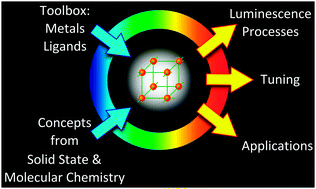Engineering metal-based luminescence in coordination polymers and metal–organic frameworks
Abstract
The rapidly growing number of luminescent coordination polymers (CPs) and metal–organic frameworks (MOFs) illustrates high interest as well as accessibility of such materials. The interplay between inorganic and organic components in these materials offers a large number of viable luminescence processes. The enormous variability of available ligand–metal combinations opens the possibility of creating luminescence “by design”, based on a proper understanding of the processes involved. Together with the multifunctionality of MOFs (e.g. porosity) further options like sensing become accessible. This tutorial review covers the main luminescence processes and focuses especially on metal-based luminescence of coordination polymers and MOFs.


 Please wait while we load your content...
Please wait while we load your content...